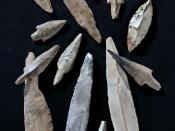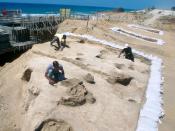The Divergence Between the Paleolithic Age and the Neolithic Revolution
Marina Lundstrom
History 114 - Western Civilization & The World I
Due: September 25, 2014
In c. 2,500,000 the earliest prehistoric period in human history known as the Paleolithic Age began. This period consisted of three epochs, Lower, Middle, and Upper Paleolithic that were divided in terms of the fluctuation of climate temperatures. The Neolithic Revolution followed shortly after the last ice age, and at the end of the Upper Paleolithic, around 10,000 B.C.E. Similar to the Paleolithic Age, the Neolithic Revolution is divided into three periods by pottery phases; Pre-Pottery Neolithic A (PPNA), Pre-Pottery Neolithic B (PPNB), and Pottery Neolithic (PN). Both terms "Paleolithic" and "Neolithic" were derived from Greek, which translate to "Old Stone Age" and "New Stone Age," respectively. These derivations characterize the creation of primitive stone tools from the "Old Stone Age" to the advanced use of them in the "New Stone Age".
Although the handling of these tools was vital in the daily lives of these ancient people, the development of them was not the chief difference between both periods. The primary changes were focused on the evolution of these ancient peoples' nutrition, living situations, occupations, and gender roles.
The average society, or band of Paleolithic hominoids depended on searching for sustenance on foot. Hunting animals such as bears, rabbits, and deer was a necessity to obtain meat and animal hide to make clothing. Without the use of primitive technology, it would have been difficult for these humans to survive. Knapped stone weapons were a crucial part of hunting wild animals and more spherical, rough textured lumps of stone "may have served as crude missiles of self-defense hurled against predatorsâ¦"1 A selection of stone tools, depicted in a photograph taken by J. Oster in Secrets of the Ice Age: The World of the Cave Artists, used during the Middle to Upper Paleolithic era seemed to vary from size, grain, and shape depending on the technique our ancient predecessors used.2 Most of the flint ground tools shown have a sharp, spade-like form and look suitably compact enough for a Paleolithic hunter to arm. Judging by their bulbous core, the blunt stone artifacts in the photograph are noticeably heavier, and appear to be used as secondary or defense weapons.[1: 1. Evan Hadingham, Secrets of the Ice Age: The World of the Cave Artists (New York: Walker and Company, 1979), 31. 2. J. Oster, "Paleolithic Tools," in Secrets of the Ice Age: The World of the Cave Artists, by Evan Hadingham (New York: Walker and Company, 1979), 67. Black and white.]
There was a division of labor by sex among these bands, as men were often far from camp hunting or fishing, while women foraged the land for wild plants, nuts, and berries. However, there are exceptions in some cultures such as the Agta people of the island Luzon in the Philippines whose women "hunt and collect only those animal species which do not require the use of spears, spear throwers, heavy clubs, or bows and arrows."3 Despite this division of labor, both men and women were roughly equal in their cooperation in providing for their band's survival. "[The Paleolithic male] sees himself as the hunter but then he could not hunt without a wife, and although hunting is more exciting than being a beater or a gatherer, he knows that the bulk of his diet comes from the goods prepared by the women."4 The lives of the Paleolithic focused primarily on survival, and maintaining a nomadic way of life in order to follow their food sources when the land would be depleted of vegetation and animals. This restricted supply of food required the nomads to travel in small bands of twenty to thirty people. [2: 3. Barbara D. Miller, Sex and Gender Hierarchies (Cambridge: Cambridge University Press, 1993), 58. ][3: 4. Ibid., 59. ]
A traveling band would have to retreat in rudimentary shelters built out of wood, straw, rock, and animal pelts, but caves were also feasible for migratory groups in cold climates. Surprisingly, the walls and ceilings of their caves had been painted on as if they were used as canvases. Wild animals such as birds, horses, mammoths, fish, and bulls were the main figures in these realistic cave paintings. Photographed by the American Museum of Natural History, featured in Ancient History: From Prehistoric Times to the Death of Justinian, is one of the most famous Paleolithic art pieces to date; a complex cave drawing of a horse in Altamira, Spain.4 This "Horse and hind" polychrome artwork is displayed on the top left of the Altamira cave's ceiling in a 45.5 foot mural. The polychrome piece appears to be drawn in a dark colored ochre that was smeared and airbrushed inside of a charcoal outline of the horse. Another horse with pointed, alert ears had been engraved over the main figure with a sharp instrument. The curves and shadows of the horse are vivid, especially the smaller details of the ears, muzzle, and hoof. It is suggested that the act of painting these pictures gave the Paleolithic hope to repel dangerous animals from their territory and increase the band's food supply. 5[4: 4. American Museum of Natural History, "Horse and hind from Altamira," in Ancient History: From Prehistoric Times to the Death of Justinian, by Charles Alexander Robinson, Jr. (New York: Macmillan, 1951), 22. Black and white. ][5: 5. Charles Alexander Robinson, Jr., Ancient History: From Prehistoric Times to the Death of Justinian (New York: Macmillan, 1951), 24. ]
Fortunately, in the Neolithic Revolution, people no longer had to depend on painting in their crude homes to reduce the scarcity of sustenance. Agricultural means and animal domestication soon replaced food gathering-and-hunting. There is much speculation about how this significant transition to domesticating plants and animals occurred, but one of the first theories that contribute to this agricultural revolution is the Oasis-Propinquity Theory. In 1928, Near Eastern archaeologist, V. Gordon Childe, popularized this transition model with the hypothesis that a "major climatic change at the end of the Pleistocene caused the drying of broad areas, changing them into deserts. Accordingly, plants and animals were dying or becoming scarce. This was true except for desert oases and river valleys."6 Humans, plants, and animals were forced to live in close proximity in these damper climates, which may have led humans to realize that certain animals should be protected and that new plants would have to be consumed for the survival of both humans and animals. Through this new way of life, it came natural for humans to cultivate plants and domesticate animals.
This profound change gave the Neolithic people more control over their environment and enabled them to live in permanent villages close to their farms instead of living nomadically. Soon there was sufficient housing for the growing population and houses made with mud-bricks, instead of wood and animal hide, were their new dwellings. In Alan H. Simmons', The Neolithic Revolution in the Near East: Transforming the Human Landscape, the author himself documented one of these ancient habitats in Ghwair I, Jordan, which was discovered during the Pre-Pottery Neolithic B (PPNB), the most-investigated Neolithic Period.7 This rectangular architecture displays the common PPNB floor plan; it consists of piers made with stone bricks and mud, that link into several open rooms of the pit dwelling. There do not seem to be floors in this particular construction, but the flooring in most PPNB structures were "always made of thick plaster, painted red, pink, or white, and contained multiple postholes for roof supports."8 [6: 6. Alan H. Simmons, The Neolithic Revolution in the Near East: Transforming the Human Landscape (Tucson: University of Arizona Press, 2007), 11-12. 7. Alan H. Simmons, "Well-preserved architecture at PPNB Ghwair I, Jordan," in The Neolithic Revolution in the Near East: Transforming the Human Landscape, by Alan H. Simmons. (Tucson: University of Arizona Press, 2007), 137. Black and white. ][7: 8. Ibid., 136. 9. Ibid., 115-116. ]
With these evolving communities, families, tools, and new ways to obtain food through agriculture and domesticating animals, material goods started to accumulate, which helped emerge trade and crafting. Trade in the Neolithic Period took place in short and long distances for mostly nonlocal or rare goods. Shells, salt, sulfur and bitumen were mostly found in large settlements such as, Jericho and Netiv Hagdud in Jordan Valley, which were used for short-distance trade. Long-distance exchange items, found along the southern Rift Valley, included greenstone, material used for jewelry, weapons, and tools, and malachite, a green pigment used for paint. Obsidian or volcanic glass was the most important material exchanged for its resistance and strength in making cutting tools, which could be found in places like Jericho, Lake Van in Turkey and Tell Aswad in Syria. 9 [8: ]
To pursue travel for these short- and long-distance voyages, men learned how to construct boats and wheeled carts to trade all over the region. Crafting such as this created different careers for men and women along with a new division of labor. When agriculture was first discovered, women tilled an area of soil with a crude gardening hoe until the invention of the plow and the domestication of the ox simplified farming. Since the plow was too hard for a woman to handle, men took over farming and abandoned the role of a hunter. Other men started to work on whetstones, polishing older stone tools such as axes to chop more wood, which would lead to carpentry. Women worked in more domestic forms of craft such as pottery, and manufacturing items such as clothes and baskets in the textile industry.10 "When pushed to consider women's activities in Neolithic societies, authors sometimes provide a litany of women's economic tasks including house construction, food preparation, water and wood gathering, planting fields, tending crops, harvesting, caring for domestic animals, cleaning, and refuse disposal."11 [9: 10. Charles Alexander Robinson, Jr., Ancient History: From Prehistoric Times to the Death of Justinian (New York: Macmillan, 1951), 27. 11. Sarah M. Nelson, Handbook of Gender in Archaeology (Lanham: AltaMira Press, 2006), 550. ][10: ]
There have been many divergences between the Paleolithic Age and the Neolithic Revolution. Many of the significant changes that took place in the Neolithic Revolution became building blocks of a civilization such as agriculture and the domestication of animals, new occupations made through crafting, widespread trade, and even the architecture of buildings. Men and women evolved from living nomadically, with each sex playing the role of hunter or gatherer for the survival of the Paleolithic band, to settling in more stable, populated communities either farming, crafting, or trading in order to keep the cycle of life flowing.
Bibliography
Hadingham, Evan. Secrets of the Ice Age: The World of the Cave Artists. New York: Walker and Company, 1979.
Miller, Barbara D. Sex and Gender Hierarchies. Cambridge: Cambridge University Press, 1993.
Nelson, Sarah M. Handbook of Gender in Archaeology. Lanham: AltaMira Press, 2006.
Robinson, Charles Alexander, Jr. Ancient History: From Prehistoric Times to the Death of Justinian. New York: Macmillan, 1951.
Simmons, Alan H. The Neolithic Revolution in the Near East: Transforming the Human Landscape. Tucson: University of Arizona Press, 2007.
[Type text] [Type text] [Type text]


